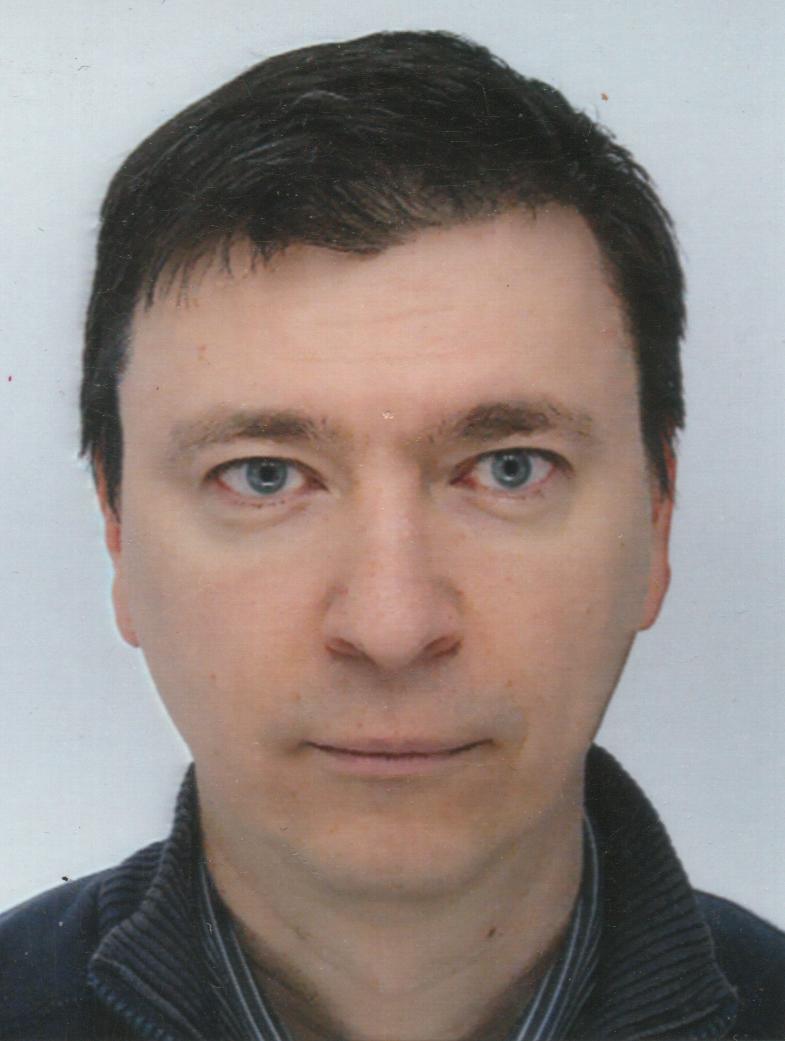
Service de Physique de l’État Condensé (SPEC),
Groupe Modélisation et Théorie (GMT),
Site de l’Orme des merisiers
CEA Saclay, 91191 Gif sur Yvette,
FRANCE
Fonction
Physicist
Research interests
- Ab initio DFT (Density Functional Theory) electronic structure calculations;
- Electron transport in magnetic nanostructures – theory and simulations;
- Molecular spintronics;
- Nanomagnetism and magnetic anisotropy from ab initio;
- Kondo physics in realistic nanosystems.
CV
EDUCATION
11/1999
Ph.D. in Physics and Mathematics, Voronezh Technical University
Thesis: Electronic structure and optical properties of simple metal wires
Advisor: prof. Kurkina L.I.
09/1995 – 09/1998
Post-graduate student at Voronezh State University, Department of Solid State Physics.
06/1995
Degree of Magister of Physics, Voronezh State University.
POSITIONS HELD
01/2010 – present
Permanent researcher position, SPEC/GMT, CEA Saclay, France.
09/2006 – 01/2010
Post-doctoral researcher at the International Centre for Theoretical Physics (ICTP), Trieste, Italy.
10/2002 – 09/2006
Associate researcher at the International School for Advanced Studies (SISSA), Trieste, Italy
10/2000 – 10/2002
Post-doctoral researcher at the International School for Advanced Studies (SISSA), Trieste, Italy.
09/1999 – 09/2000
Assistant Professor, Forestry Engineering Academy, Voronezh, Russia.
PWcond
DFT (Density Functional Theory) plane wave code to study ballistic electron transport in atomic scale nanosystems.
The code PWcond (a part of Quantum-Espresso electronic structure package) is designed to study quantum systems with open boundary conditions consisting of semi-infinite left and right leads bridged by the scattering region:
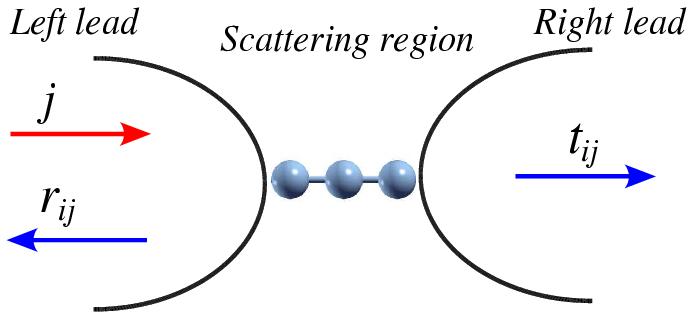
The code solves the quantum-mechanical scattering problem and finds reflection rij and transmission tij amplitudes for electron waves j propagating from the left to the right. The total transmission at the Fermi energy, T(EF)=∑ij |tij(EF)|2, then determines the linear ballistic conductance, G, via Landauer-Buttiker formula, G=(e2/h)T(EF).
PWcond has been developed mainly by myself and Andrea Dal Corso (SISSA).
Main ingredients of the code: – Density Functional Theory (DFT);
- Plane waves basis set for expanding electron wave functions;
- Norm-conserving and ultrasoft pseudo potentials to describe electron-ion interactions;
- Noncollinear magnetism and spin-orbit coupling
REFERENCES
- General references on electron transport in atomic scale conductors:
- My notes on electron transport (Porquerolles 2024)
- S. Datta,« Electronic transport in mesoscopic systems », Cambridge, University Press, 1995.
- D. K. Ferry and S. M. Goodnick,« Transport in nanostructures », Cambridge, University Press, 1999.
- M. Di Ventra,« Electrical transport in nanoscale systems », Cambridge: Cambridge University Press, 2008.
- E. Scheer, J. C. Cuevas, « Molecular Electronics: An Introduction To Theory And Experiment« , 2017.
- M. Pourfath, « The Non-Equilibrium Green’s Function Method for Nanoscale Device Simulation », 2014.
- P. A. Mello, N. Kumar, « Quantum Transport in Mesoscopic Systems: Complexity and Statistical Fluctuations« , 2004.
- Main references on the computational scheme implemented in PWcond:
- H. J. Choi and J. Ihm, Phys. Rev. B 59, 2267 (1999).
- A. Smogunov, A. Dal Corso, E. Tosatti, Phys. Rev. B 70, 045417 (2004) (arXiv:cond-mat/0405433).
TBcond
Scientific publications
2015
P. P. Baruselli, R. Requist, A. Smogunov, M. Fabrizio, and E. Tosatti,
Co adatoms on Cu surfaces: Ballistic conductance and Kondo temperature,
Phys. Rev. B 92, 045119 (2015), (DOI: http://dx.doi.org/10.1103/PhysRevB.92.045119)
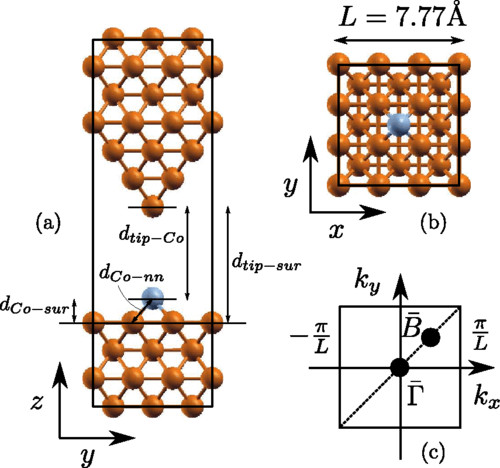
The Kondo zero-bias anomaly of Co adatoms probed by scanning tunneling microscopy is known to depend on the height of the tip above the surface, and this dependence is different on different low index Cu surfaces. On the (100) surface, the Kondo temperature first decreases then increases as the tip approaches the adatom, while on the (111) surface it is virtually unaffected. These trends are captured by combined density functional theory and numerical renormalization-group calculations. The adatoms are found to be described by an S=1 Anderson model on both surfaces, and ab initio calculations help identify the symmetry of the active d orbitals. We correctly reproduce the Fano line shape of the zero-bias anomaly for Co/Cu(100) in the tunneling regime but not in the contact regime, where it is probably dependent on the details of the tip and contact geometry. The line shape for Co/Cu(111) is presumably affected by the presence of surface states, which are not included in our method. We also discuss the role of symmetry, which is preserved in our model scattering geometry but most likely broken in experimental conditions.
K. Bairagi et al.,
Tuning the Magnetic Anisotropy at a Molecule-Metal Interface,
Phys. Rev. Lett. 114, 247203 (2015), (DOI: 10.1103/PhysRevLett.114.247203).
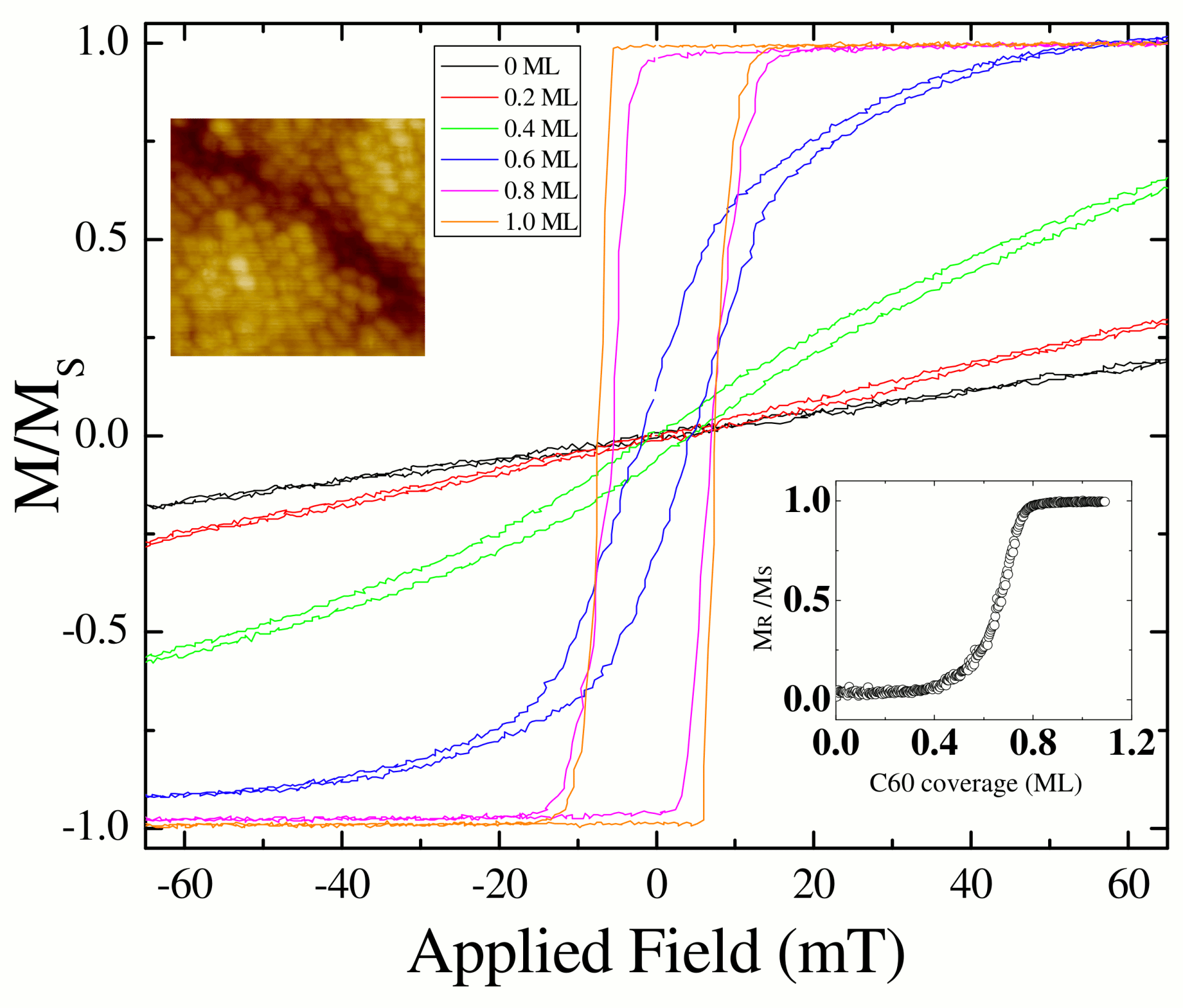
We demonstrate that a C60 overlayer enhances the perpendicular magnetic anisotropy of a Co thin film, inducing an inverse spin reorientation transition from in plane to out of plane. The driving force is the C60/Co interfacial magnetic anisotropy that we have measured quantitatively in situ as a function of the C60 coverage. Comparison with state-of-the-art ab initio calculations show that this interfacial anisotropy mainly arises from the local hybridization between C60 p_z and Co d_z2 orbitals. By generalizing these arguments, we also demonstrate that the hybridization of C60 with a Fe(110) surface decreases the perpendicular magnetic anisotropy. These results open the way to tailor the interfacial magnetic anisotropy in organic-material–ferromagnet systems.
A. Smogunov, Y. J. Dappe,
Symmetry-Derived Half-Metallicity in Atomic and Molecular Junctions,
Nano Lett. 15, 3552 (2015), (DOI: 10.1021/acs.nanolett.5b01004).
See abstract

Achieving highly spin-polarized electric currents in atomic-scale junctions is of great importance in the field of nanoelectronics and spintronics. Based on robust symmetry considerations, we propose a mechanism to block completely one of spin conduction channels for a broad class of atomic and molecular junctions bridging two ferromagnetic electrodes. This particular behaviour is due to the wave-function orthogonality between spin up s-like states in ferromagnetic electrode and available π-channels in the junction. As a consequence, the system would ideally yield 100 % spin-polarized current, with a junction acting thus as a « half-metallic » conductor. Using ab initio electron transport calculations, we demonstrate this principle on two examples: i) a short carbon chain and ii) a π-conjugated molecule (polythiophene) connected either to model semi-infinite Ni wires or to realistic Ni(111) electrodes. It is also predicted that such atomic-scale junctions should lead to very high (ideally, infinite) magneto-resistance ratios since the electric current gets fully blocked if two electrodes have anti-parallel magnetic alignment.
P. Yang et al.,
C-60 as an Atom Trap to Capture Co Adatoms,
JOURNAL OF PHYSICAL CHEMISTRY C 119, 6873 (2015), (DOI: 10.1021/jp512723c)
See abstract

C60 molecules were used to trap Co adatoms and clusters on a Au(111) surface using atomic/molecular manipulation with a scanning tunneling microscope. Two manipulation pathways (successive integration of single Co atoms in one molecule or direct integration of a Co cluster) were found to efficiently allow the formation of complexes mixing a C60 molecule with Co atoms. Scanning tunneling spectroscopy reveals the robustness of the π states of C60 that are preserved after Co trapping. Scanning tunneling microscopy images and density functional theory calculations reveal that dissociated Co clusters of up to nine atoms can be formed at the molecule-substrate interface. These results open new perspectives in the interactions between metal adatoms and molecules, for applications in metal-organic devices.
2014
D. Li, C. Barreteau, M. R. Castell, F. Silly, A. Smogunov,
Out- versus in-plane magnetic anisotropy of free Fe and Co nanocrystals: Tight-binding and first-principles studies,
Phys. Rev. B 90, 205409 (2014), (DOI: 10.1103/PhysRevB.90.205409)
See abstract
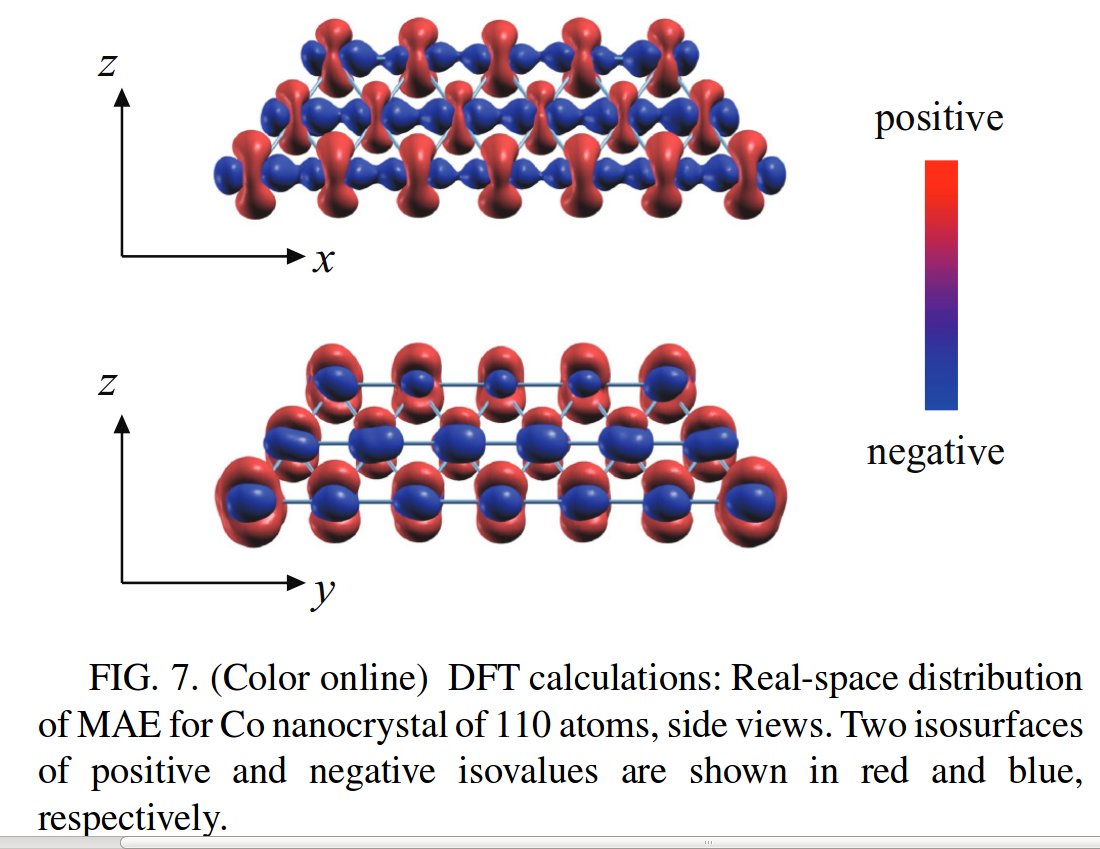
We report tight-binding and density functional theory calculations of magnetocrystalline anisotropy energy (MAE) of free Fe (body-centered-cubic) and Co (face-centered-cubic) slabs and nanocrystals. The nanocrystals are truncated square pyramids which can be grown experimentally by deposition of metal on a SrTiO3(001) substrate. For both elements our local analysis shows that the total MAE of the nanocrystals is largely dominated by the contribution of (001) facets. However, while the easy axis of Fe(001) is out-of-plane, it is in-plane for Co(001). This has direct consequences on the magnetic reversal mechanism of the nanocrystals. Indeed, the very high uniaxial anisotropy of Fe nanocrystals makes them a much better potential candidate for magnetic storage devices.
R. Requist, S. Modesti, P.P. Baruselli, A. Smogunov, M. Fabrizio, E. Tosatti,
Kondo conductance across the smallest spin 1/2 radical molecule,
PNAS 111, 69 (2014), (DOI: 10.1073/pnas.1322239111)
See abstract

Molecular contacts are generally poorly conducting because their energy levels tend to lie far from the Fermi energy of the metal contact, necessitating undesirably large gate and bias voltages in molecular electronics applications. Molecular radicals are an exception because their partly filled orbitals undergo Kondo screening, opening the way to electron passage even at zero bias. Whereas that phenomenon has been experimentally demonstrated for several complex organic radicals, quantitative theoretical predictions have not been attempted so far. It is therefore an open question whether and to what extent an ab initio-based theory is able to make accurate predictions for Kondo temperatures and conductance lineshapes. Choosing nitric oxide (NO) as a simple and exemplary spin 1/2 molecular radical, we present calculations based on a combination of density functional theory and numerical renormalization group (DFT+NRG), predicting a zero bias spectral anomaly with a Kondo temperature of 15 K for NO/Au(111). A scanning tunneling spectroscopy study is subsequently carried out to verify the prediction, and a striking zero bias Kondo anomaly is confirmed, still quite visible at liquid nitrogen temperatures. Comparison shows that the experimental Kondo temperature of about 43 K is larger than the theoretical one, whereas the inverted Fano lineshape implies a strong source of interference not included in the model. These discrepancies are not a surprise, providing in fact an instructive measure of the approximations used in the modeling, which supports and qualifies the viability of the density functional theory and numerical renormalization group approach to the prediction of conductance anomalies in larger molecular radicals.
M. Viciano-Chumillas et al.,
Tailoring the Structure of Two-Dimensional Self-Assembled Nanoarchitectures Based on NiII-Salen Building Blocks,
Chemistry: A European Journal 20, 13566 (2014).
2013
P. P. Baruselli, M. Fabrizio, A. Smogunov, R. Requist, and E. Tosatti,
Magnetic impurities in nanotubes: From density functional theory to Kondo many-body effects,
Phys. Rev. B 88, 245426 (2013) (arXiv:1401.1392)
M. Kumar, O. Tal, R. H. M. Smit, A. Smogunov, E. Tosatti, J. M. van Ruitenbeek,
Shot noise and magnetism of Pt atomic chains: Accumulation of points at the boundary,
Phys. Rev. B 88, 245431 (2013)
P. V. Lukashev, J. D. Burton, A. Smogunov, J. P. Velev, E. Y. Tsymbal,
Interface states in CoFe2O4 spin-filter tunnel junctions,
Phys. Rev. B 88, 134430 (2013) (arXiv:1308.3461)
D. Li, A. Smogunov, C. Barreteau, F. Ducastelle, D. Spanjaard,
Magnetocrystalline anisotropy energy of Fe(001) and Fe(110) slabs and nanoclusters: A detailed local analysis within a tight-binding model,
Phys. Rev. B 88, 214413 (2013) (arXiv:1309.4578)
P. Habibi, C. Barreteau, A. Smogunov,
Electronic and magnetic structure of the Cr(001) surface,
J. Phys.: Condens. Matter 25, 146002 (2013)
2012
S. L. Kawahara, J. Lagoute, V. Repain, C. Chacon, Y. Girard, S. Rousset, A. Smogunov, and C. Barreteau,
Large Magnetoresistance through a Single Molecule due to a Spin-Split Hybridized Orbital,
Nano Lett. 12, 4558 (2012), (DOI: 10.1021/nl301802e)
See abstract
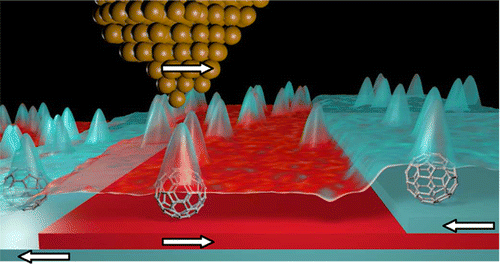
Using organic materials in spintronic devices raises a lot of expectation for future applications due to their flexibility, low cost, long spin lifetime, and easy functionalization. However, the interfacial hybridization and spin polarization between the organic layer and the ferromagnetic electrodes still has to be understood at the molecular scale. Coupling state-of-the-art spin-polarized scanning tunneling spectroscopy and spin-resolved ab initio calculations, we give the first experimental evidence of the spin splitting of a molecular orbital on a single non magnetic C60 molecule in contact with a magnetic material, namely, the Cr(001) surface. This hybridized molecular state is responsible for an inversion of sign of the tunneling magnetoresistance depending on energy. This result opens the way to spin filtering through molecular orbitals.
P.-P. Baruselli, A. Smogunov, M. Fabrizio, E. Tosatti,
Kondo Effect of Magnetic Impurities in Nanotubes,
Phys. Rev. Lett. 108, 206807 (2012) (arXiv:1201.3301)
G. Sclauzero, A. Dal Corso, A. Smogunov,
Interaction of CO with an Au monatomic chain at different strains: Electronic structure and ballistic transport,
Phys. Rev. B 85, 165411 (2012) (arXiv:1203.4712)
G. Sclauzero, A. Dal Corso, A. Smogunov,
Effect of stretching on the ballistic conductance of Au nanocontacts in presence of CO: A density functional study,
Phys. Rev. B 85, 165412 (2012) (arXiv:1203.4713)
2009
2010 P. Gava, A. Dal Corso, A. Smogunov, E. Tosatti,
Magnetism-induced ballistic conductance changes in palladium nanocontacts,
EUROPEAN PHYSICAL JOURNAL B 75, 57 (2010)
P. Lucignano, R. Mazzarello, A. Smogunov, M. Fabrizio, E. Tosatti,
Kondo conductance in an atomic nanocontact from first principles,
Nature Materials 8, 563 (2009)
J. Velev, C.-G. Duan, J. Burton, A. Smogunov, M. Niranjan, E. Tosatti, S. Jaswal, E. Tsymbal,
Magnetic tunnel junctions with ferroelectric barriers: Prediction of four resistance states from first-principles,
Nano Lett. 9, 427 (2009) (arXiv:0812.2393)
P. Giannozzi et al.,
QUANTUM ESPRESSO: a modular and open-source software project for quantum simulations of materials,
J. Phys. Condens. Matter 21, 395502 (2009)
2008
A. Smogunov, A. Dal Corso, A. Delin, R. Weht, E. Tosatti,
Colossal magnetic anisotropy of monatomic free and deposited platinum nanowires,
Nature Nanotechnology 3, 22-25 (2008)
Y. Miura, R. Mazzarello, A. Dal Corso, A. Smogunov, E. Tosatti,
Monatomic Au wire with a magnetic Ni impurity: Electronic structure and ballistic conductance,
Phys. Rev. B 78, 205412 (2008)
G. Sclauzero, A. Dal Corso, A. Smogunov, E. Tosatti,
Interaction of a CO molecule with a Pt monatomic wire: Electronic structure and ballistic conductance,
Phys. Rev. B 78, 085421 (2008) (arXiv:0809.0644)
A. Smogunov, A. Dal Corso, E. Tosatti,
Magnetic phenomena, spin-orbit effects, and electron transport in Pt nanowire contacts,
Phys. Rev. B 78, 014423 (2008) (arXiv:0804.3340)
2006
A. Dal Corso, A. Smogunov, E. Tosatti,
Ab initio ballistic conductance with spin-orbit coupling: Application to monoatomic wires,
Phys. Rev. B 74, 045429 (2006)
A. Smogunov, A. Dal Corso, E. Tosatti,
Ballistic conductance and magnetism in short tip suspended Ni nanowires,
Phys. Rev. B 73, 075418 (2006) (arXiv:cond-mat/0601608)
2004
A. Smogunov, A. Dal Corso, E. Tosatti,
Ballistic conductance of magnetic Co and Ni nanowires with ultrasoft pseudo-potentials,
Phys. Rev. B 70, 045417 (2004) (arXiv:cond-mat/0405433)
A. Smogunov, A. Dal Corso, E. Tosatti,
Ballistic conductance of Ni nanowire with a magnetization reversal,
Surf. Sci. 566-568, 390 (2004) (arXiv:cond-mat/0310335)
< 2004
F. Picaud, A. Smogunov, A. Dal Corso, E. Tosatti,
Complex Band Structures and Decay Length in Polyethylene Chains,
J. Phys.: Condens. Matter 15, 3731-3740, (2003) (arXiv:cond-mat/0305308)
A. Smogunov, A. Dal Corso, E. Tosatti,
Complex band structure with ultrasoft pseudopotentials: fcc Ni and Ni nanowire,
Surf. Sci. 532-535, 549-555, (2003) (arXiv:cond-mat/0302100)
A. Smogunov, A. Dal Corso, E. Tosatti,
Selective d-state conducting blocking in nickel nanocontacts,
Surf. Sci. 507-510, 609, (2002) (arXiv:cond-mat/0111376)
Smogunov A.N., Kurkina L.I., Farberovich O.V.,
Linear response of embedded simple metal threads,
Surf. Sci. 469, 133-143, (2000)
Smogunov A.N., Kurkina L.I., Farberovich O.V.,
Electronic structure and polarizability of quantum metallic wires,
Phys. Solid State 42, 1898-1907, (2000)
Smogunov A.N., Kurkina L.I., Kurganskii S.I.,
Density-functional calculations of static and dynamic polarizabilities of thready cylindrical crystals,
Surf. Sci. 421, 237-245, (1999)
Smogunov A.N., Kurkina L.I., Kurganskii S.I.,
Electronic structure of simple metal whiskers,
Surf. Sci. 391, 245-251, (1997)
Litterature
- J. Rammer, « Quantum field theory of non-equilibrium states », Cambridge: Cambridge University Press, 2007.
- J. Rammer, « Quantum transport theory », Boulder, CO: Westview Press, 2004.
- M. Di Ventra, « Electrical transport in nanoscale systems », Cambridge: Cambridge University Press, 2008.
- S. Datta, « Electronic transport in mesoscopic systems », Cambridge, University Press, 1995.
- S. Datta, « Quantum transport: atom to transistor », Cambridge, University Press, 2005.
- D. K. Ferry and S. M. Goodnick, « Transport in nanostructures », Cambridge, University Press, 1999.
- R. G. Parr, « Density-functional theory of atoms and molecules », New York, NY: Oxford University Press, 1989.
- R. M. Dreizler and E. K. U. Gross, « Density functional theory: an approach to the quantum many-body problem », Berlin, Springer-Verlag, 1990.
- N. March, « The many-body problem in quantum mechanics », Cambridge, University Press, 1967.
- Ph. Phillips, « Advanced solid state physics », Boulder, CO, Westview Press, 2003.
- J.S. Griffith, « The theory of transition-metal ions », Cambridge, University Press, 1961.
Useful links
- Physics Literature (Condensed Matter Theory)
- Condensed Matter literature (SISSA CM)
- Molecular magnetism
- E-archive
- wiki
- Quantum transport guide
Projects
- Ingénierie des défauts dans les matériaux 2D: propriétés à l’échelle atomique et interaction avec des molécules (DEFINE2D) (ANR 2020)
- Orbital Engineering for Innovative Electronics (OBELIX) (Europe)


